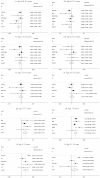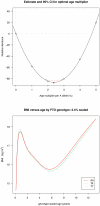Association between common variation at the FTO locus and changes in body mass index from infancy to late childhood: the complex nature of genetic association through growth and development
- PMID: 21379325
- PMCID: PMC3040655
- DOI: 10.1371/journal.pgen.1001307
Association between common variation at the FTO locus and changes in body mass index from infancy to late childhood: the complex nature of genetic association through growth and development
Abstract
An age-dependent association between variation at the FTO locus and BMI in children has been suggested. We meta-analyzed associations between the FTO locus (rs9939609) and BMI in samples, aged from early infancy to 13 years, from 8 cohorts of European ancestry. We found a positive association between additional minor (A) alleles and BMI from 5.5 years onwards, but an inverse association below age 2.5 years. Modelling median BMI curves for each genotype using the LMS method, we found that carriers of minor alleles showed lower BMI in infancy, earlier adiposity rebound (AR), and higher BMI later in childhood. Differences by allele were consistent with two independent processes: earlier AR equivalent to accelerating developmental age by 2.37% (95% CI 1.87, 2.87, p = 10(-20)) per A allele and a positive age by genotype interaction such that BMI increased faster with age (p = 10(-23)). We also fitted a linear mixed effects model to relate genotype to the BMI curve inflection points adiposity peak (AP) in infancy and AR. Carriage of two minor alleles at rs9939609 was associated with lower BMI at AP (-0.40% (95% CI: -0.74, -0.06), p = 0.02), higher BMI at AR (0.93% (95% CI: 0.22, 1.64), p = 0.01), and earlier AR (-4.72% (-5.81, -3.63), p = 10(-17)), supporting cross-sectional results. Overall, we confirm the expected association between variation at rs9939609 and BMI in childhood, but only after an inverse association between the same variant and BMI in infancy. Patterns are consistent with a shift on the developmental scale, which is reflected in association with the timing of AR rather than just a global increase in BMI. Results provide important information about longitudinal gene effects and about the role of FTO in adiposity. The associated shifts in developmental timing have clinical importance with respect to known relationships between AR and both later-life BMI and metabolic disease risk.
Conflict of interest statement
The authors have declared that no competing interests exist.
Figures




References
-
- Dina C, Meyre D, Gallina S, Durand E, Korner A, et al. Variation in FTO contributes to childhood obesity and severe adult obesity. Nature Genetics. 2007;39:724–726. - PubMed
-
- Hinney A, Nguyen TT, Scherag A, Friedel S, Bronner G, et al. Genome wide association (GWA) study for early onset extreme obesity supports the role of fat mass and obesity associated gene (FTO) variants. PLoS ONE. 2007;2:e1361. doi: 10.1371/journal.pone.0001361. - DOI - PMC - PubMed
-
- Scuteri A, Sanna S, Chen W, Uda M, Albai G, et al. Genome-wide association scan shows genetic variants in the FTO gene are associated with obesity-related traits. PLoS Genet. 2007;20:e115. doi: 10.1371/journal.pgen.0030115. - DOI - PMC - PubMed
Publication types
MeSH terms
Substances
Grants and funding
- R01 MH063706/MH/NIMH NIH HHS/United States
- MOP-82893/CAPMC/ CIHR/Canada
- R01 HL087679/HL/NHLBI NIH HHS/United States
- BHF_/British Heart Foundation/United Kingdom
- G07000961/MRC_/Medical Research Council/United Kingdom
- 092731/WT_/Wellcome Trust/United Kingdom
- DH_/Department of Health/United Kingdom
- 1RL1MH083268-01/MH/NIMH NIH HHS/United States
- G0500539/MRC_/Medical Research Council/United Kingdom
- CRUK_/Cancer Research UK/United Kingdom
- 5R01MH63706-02/MH/NIMH NIH HHS/United States
- G0700961/MRC_/Medical Research Council/United Kingdom
- 5R01HL087679-02/HL/NHLBI NIH HHS/United States
- RL1 MH083268/MH/NIMH NIH HHS/United States
- D13460/BB_/Biotechnology and Biological Sciences Research Council/United Kingdom
- G9815508/MRC_/Medical Research Council/United Kingdom
- G0600705/MRC_/Medical Research Council/United Kingdom
LinkOut - more resources
Full Text Sources
Research Materials

